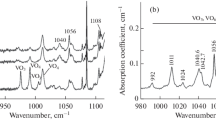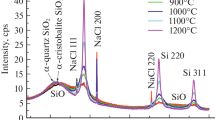Abstract
The high-temperature X-ray diffraction method showed the presence of two phase states of oxygen in the volume of a single crystal of silicon grown by the Czochralski method: a dissolved (interstitial) state in the composition of “quasimolecules”—SiO2 and a chemically bound (precipitate) state in the composition of silicon dioxide—SiO2; the precipitate state of oxygen in the bulk of silicon is in the form of crystalline SiO2(c), and in the near-surface layer of a single crystal in the amorphous form of SiO2(a). The thermally stimulated transformation of oxygen atoms between dissolved and precipitate states of oxygen in crystalline form in the bulk of a silicon single crystal has been established.
Similar content being viewed by others
Data Availability
No datasets were generated or analysed during the current study.
References
Silicon Nanocrystals: Fundamentals, Synthesis and applications / Eds. L. Pavesi, R. Turan. Wienheim: Wiley – VCH, 2010, p 648
Gerasimenko NN, Yu N (2006) Parkhomenko. Silicon is a nanoelectronics material. – M.: Tekhnosphere, p 352
Hideki T (2004) Present status and prospect of si wafer for ultra large scale integration. Japan J Appl Phys 43(7A):4055–4067
Zulehner W (1983) Czochralski Grown of Silicon. J Cryst Growth 65(1–3):189–213
Babich VM, Bletskan NI, Wenger EF (1997) Oxygen in silicon single crystals. Kiev “Interpres LTD”, 7; 16; 27; 31; 33; 90; 97–98
Ravey KV (1984) Defects and impurities in semiconductor silicon. Trans. from Engl. – M.: Mir, 27; 30; 80; 134; 158;180; 256–257; 415
ASTM F1188–00 (2000) Standard test method for interstitial atomic oxygen content of silicon by infrared absorption [Text]. - ASTM International, West Conshohocken, PA. https://doi.org/10.1520/f1188-00
ASTM F1391–93 (2000) Standard test method for substitutional atomic carbon content of silicon by infrared absorption [Text]. ASTM International, West Conshohocken, PA. https://doi.org/10.1520/f1391-93r00.
Kolbesen OB, Mvhlbauer A (1982) Carbon in silicon: Properties and impact on devices. Solid State Electron 25(8):759–775
Newman RC (1982) Defects in silicon. Rep Prog Phys 45:1163–1210
Ourmazd A, Schroter W, Bourret A (1984) Oxygen-related thermal donors in silicon. A new structural and kinetic model. J Appl Phys. 56(6):557–564
Jastrebski L, Zanzucchi P, Thebault D, Lagowski J (1982) Method to measure the precipitated and total oxygen concentration in silicon. J Electrochem Soc 129(7):1638–1641
Szekeres A (1998) Stress in the SiO2/Si structures formed by thermal oxidation. NATO Sci Series 3 High Technol 47:65–73
Fadeev AV, Nine YuN (2019) Model of thermal oxidation of silicon. ZhTP 89(4):620–626
Burappa K, Ohachi T (2003) Crystal Growth technology –Springer, 180–200
Voronkov VV, Voronkova GI, Zubov BV et al (1979) Impurity clouds in dislocation-free silicon. Phys Technol Semiconduct 13(5):846–853
Lin W, Stavola M (1985) Oxygen segregation and microscopic inhomogeneity in czochralski silicon. J Electrochem Soc 132(6):1412–1416
Rava P, Gatos HC, Lagowski J (1982) Thermally activated oxygen donors in Si. J. Electrochem Soc. 129(12):2844–2849
Vasiliev AG, Smagulova SA, Shaimeev SS (1983) Method for monitoring oxygen content in silicon. Institute of Semiconductor Physics, Siberian Branch of the USSR Academy of Sciences. Patent. SU/3–999128. Date of publication: 02.23.1983
Gorelik SS, Rostorguev LN, Skakov YA (1970) X-ray and electron-optical analysis. – M.: Metallurgy, 72; 89
Gorelik SS, Rostorguev LN, Skakov YA (1970) X-ray and electron-optical analysis. Applications. – M.: Metallurgy, p13
Kiselev VK, Obolensky SV, Skupov VD (1999) The influence of the internal getter in silicon on the parameters of Au-Si structures. ZhTP 69(6):129–131
Shulpina IL, Kyutt RN, Ratnikov VV, Prokhorov IA, Bezbakh IZ, Shcheglov MP (2010) Methods of X-ray diffraction diagnostics of heavily doped semiconductor single crystals. ZhTP 80(4):105–114
Yasutake R, Umeno M, Kawabe H (1984) Oxygen precipitation and microdefects in czochralski grown silicon crystals. Phys Stat Solid (a) 83(1):207–217
Newman RC, Oates AS, Livingston FM (1983) Self–interstitials abd thermal donor formayion in silicon: New measurements and a Model for the Sefects. J Phys C Solid State Phys 16(19):L667–L674
Helmreich D, Sirtl E (1977) Oxygen in silicon: A modern view. In: Semiconductor Silicon, 1977. Edited by H.R.Huff and E. Sirtl (Electrochemical Society, Pennington, New Jersey, 626–636
Kalanov MU, Khugaev AV (2021) α –β Phase transition in the impurity phase of a single crystal of silicon SiO2. Letters to ZhTP 47(7):22–25. https://doi.org/10.21883/PJTF.2021.07.50794.18623
Acknowledgements
The authors are sincerely grateful to B.S. Yuldashev for constant attention and support at all stages of this scientific research.
Funding
The Fundamental Research Programs of the Uzbekistan Academy of Sciences financially supported this work.
Author information
Authors and Affiliations
Contributions
M.U. Kalanov: Writing-review & editing, I.I. Sadikov: Writing-original draft, A.V. Khugaev: Validation, Data curation, Sh.R.Malikov: Project administration, A.S. Saidov: Funding acquisition. Sh.N. Usmonov: Supervision. D.V.Saparov: carried out the experiment and writing original manuscript.
Corresponding author
Ethics declarations
Ethical Approval
All author declared that the entire ethical standard required for the preparation and publication are complied.
Consent to Participate
All person named as author in this manuscript have participated in the planning, design and performance of the research.
Consent for Publication
All authors have indorsed the publication of this research.
Competing Interests
The authors declare no competing interests.
Additional information
Publisher's Note
Springer Nature remains neutral with regard to jurisdictional claims in published maps and institutional affiliations.
Rights and permissions
Springer Nature or its licensor (e.g. a society or other partner) holds exclusive rights to this article under a publishing agreement with the author(s) or other rightsholder(s); author self-archiving of the accepted manuscript version of this article is solely governed by the terms of such publishing agreement and applicable law.
About this article
Cite this article
Kalanov, M.U., Sadikov, I.I., Khugaev, A.V. et al. Thermally Stimulated Transformation of Oxygen Atoms Between Phase States in a Silicon Single Crystal. Silicon (2024). https://doi.org/10.1007/s12633-024-02985-y
Received:
Accepted:
Published:
DOI: https://doi.org/10.1007/s12633-024-02985-y




